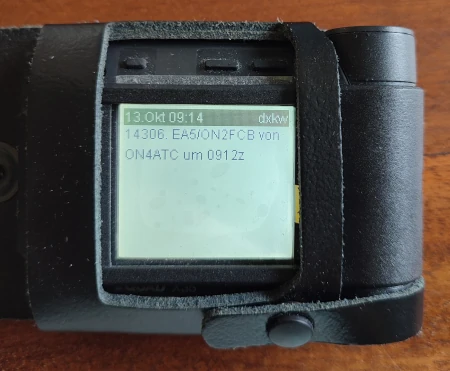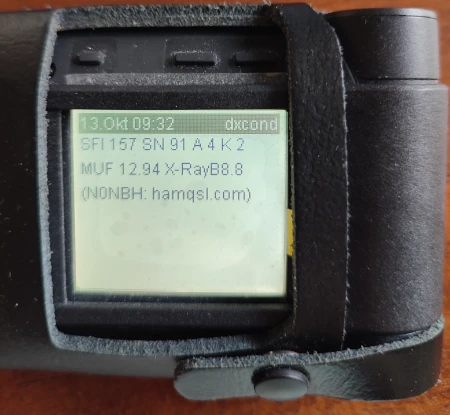
DXing
Signals from all over the globe have attracted me since ever. I remember listening to far away ships with a world receiver radio in my childhood and of course the famous german coast station Norddeich Radio. Latter one preferably when visiting family members in Eastern Frisia since reception in my hometown was hardly possible due to being in skip zone on shortwave and lack of good long- and medium-wave antennas. After listening for some years I got fascinated by the wish to transmit and participate in the worldwide radio business. I had collected quite a number of SWL QSL cards and was familiar to the ham radio business concerning operation and law issues. Learning technical stuff was quite a challenge beside passing secondary school. Meanwhile I could link both and successfully pass a student research project in physics dealing with some basic HF stuff (oscillators, modulation and data transmission) and visualisation with CASSY Lab software compared to generic analogue oscilloscopes.
German entry level licence (passed in 2001) allowed operation on VHF and UHF at 10 watts EIRP maximum. Quite nonsense when aiming at worldwide contacts, so I began to learn CW which still was obligatory for shortwave access these days. Different from today there was no chance to do an licence upgrade, so you had to pass all four parts of the advanced licencs (technical stuff, operation, legal stuff and morse examination) from scratch. Fortunately that secured me from being bored during matura period, so in 2005 all young men's challenges (matura, advanced licence ham radio and driving licence) were passed. Just when applying for the ham radio examination, the federal agency decided to abstain morse code knowledge for shortwave access, followed by the fusion of former classes 1 and 2 ham radio licence to a new class A offering full access to all ham radio bands with up to 750 watts output.
Besides university studies a competitive ham radio station was gathered throughout the years. DXCC confirmations rised quickly; unfortunately only the first one hundert and something, than it's getting more and more time consuming to add more rare ones. After some years of lower activity due to professional and other reasons, I moved to Belgium in 2017. What a luck, DXCC counter starts at zero again since you can not combine your personal statistics in different DXCC entities - yeah. While initially being fenced in worse HF living conditions (don't rent a flat in a valley), I evolved my ham radio station in Germany into a remote-control rig. Quite a fascinating thing to do if you are not willing to spent a lot for some ready to use stuff. Fortunately I am also able to build a second rig in Belgium after having moved to a much better place - not only in terms of HF concerns :-)
DX cluster messages in DAPNET

While hanging around at the ham radio group of the local university (most of the time as the only non-engineering-student), Ralf DH3WR initiated a new approach to a german ham radio paging network. To enhance content and attractiveness, we thought of including dx cluster news into the network; that had been very nice in the predecessor system (FunkrufMaster) as well. So I developed some script stuff that does the job. It has been working for several years now and still delivers a relevant amount of traffic information. To be independent in development, debugging and, hm, why not, I decided to raise my own DX-Cluster node. So everything in soft- and hardware is under my direct control in my shack. Of course you can also use this DXspider instance, just feel free to connect to dx.on5mm.be (Port 7300/tcp, IPv4 only). According to the latest (gentlemen) agreement of DXspider sysops, you need to register first and login is password-secured. Just drop me a mail if you like to gain access.
Individual DX Alerts via DAPNET
I've prepared an enhancement of the general DX cluster service via DAPNET. You can register with your RIC/callsign and create a kind of watchlist. Whenever a call of this list is spotted first (on your desired band, in your desired mode), you can get an individual message on your pager containing the details. It's just comparable to the famous iOS-/Android-App HamAlert. As you can imagine, some aspects have to be adressed, for example limiting the amount of alert messages to improve network load, which already is quite high due to the dxcluster spots.
This service is in an experimental status at the moment and some minor problems still have to be fixed. We will announce here and in DAPNET wiki when going live.
ConDX broadcast via DAPNET

There are also regular broadcasts of the current solar data via DAPNET. A script gathers all information from N0NBH webpage and creates messages in skyper rubric "Conditions" and a message to broadcast ric 1009 (for use with non-skyper pagers).
The rubric ids not only of the dx cluster spots are well documented and regularly updated here.
I run a DAPNET transmitter but it does not transmit any dx spots. (Or: I do not receive any spots via my local TX, why?)
Uah, you are the very first one with that issue. Not :-) A very common question in nearly every DAPNET support channel. So for nearly everyone the solution is quite simple: The TX is not member of the tx group "dxcluster". We have had complaints about the amount of messages that is sent out for this use case, so we decided to add a separate tx group. If you (as an individual hotspot user or sysop) want your TX to broadcast DX cluster news, the callsign of the TX has to be a member of this group. Just open a ticket or contact me to do so. And, I warmly recommend the DAPNET FAQ.
DXSpiderweb
Read only access is also possible via the awesome Spiderweb Interface by IU1BOW (Thx Corrado, great work!). Just enter https://dx.on5mm.be on your {computer|smartphone|tablet|toilet screen|whatever} and enjoy...